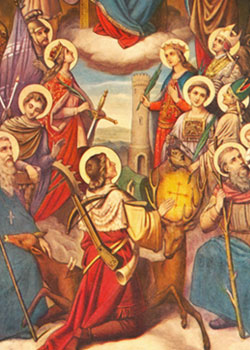 The Fourteen Holy Helpers is a title given to the fourteen saints of our church. They are regarded as ancient saints, some of whom died as early as the year 95. There was a devotion to the Fourteen Holy Helpers as early 1348 at an altar in St. Peter’s Church in Munich, Germany. Because they are the patron saints against a variety of diseases, they were called upon for help during the Black Plague epidemic in Europe from 1346 to 1349. The Fourteen Holy Helpers usually appear in pictures with the Blessed Virgin who is also known as Queen of Martyrs and Queen of All Saints.
The Fourteen Holy Helpers is a title given to the fourteen saints of our church. They are regarded as ancient saints, some of whom died as early as the year 95. There was a devotion to the Fourteen Holy Helpers as early 1348 at an altar in St. Peter’s Church in Munich, Germany. Because they are the patron saints against a variety of diseases, they were called upon for help during the Black Plague epidemic in Europe from 1346 to 1349. The Fourteen Holy Helpers usually appear in pictures with the Blessed Virgin who is also known as Queen of Martyrs and Queen of All Saints.
They are invoked as a group because of the Black Plague which devastated Europe from 1346 to 1349. Among the symptoms were tongue turning black, a parched throat, violent headache, fever, and boils on the abdomen. It attacked without warning, robbed its victims of reason, and killed within a few hours; many died without the last Sacraments. Brigands roamed the roads, people suspected of contagion were attacked, animals died, people starved, whole villages vanished into the grave, social order and family ties broke down, and the disease appeared incurable. The pious turned to Heaven, begging for intervention of the saints, praying to be spared or cured. This group devotion began in Germany, and tradition has remained strong there.
A group of saints invoked with special confidence because they have proven themselves efficacious helpers in adversity and difficulties, known and venerated under the name Fourteen Holy Helpers. Though each has a separate feast or memorial day, the group was collectively venerated on August 8th. However, this feast was dropped and suppressed in the 1969 reform of the calendar.
The Legend
According to the Legend, in the year 1445, a young shepherd, Herman Leicht, was given the opportunity to see a vision of a young child who shone like a light. When he tried to approach it, the child disappeared. he saw the child again but again it vanished. On June 28, 1446, the child again appeared but this time was surrounded by fourteen other children, all in a circle of light like a halo. Herman asked who the child was and what he wanted. The child responded by saying, “We are the Fourteen Holy Helpers and wish a chapel built here for us. Serve us and we will serve you.”
After that time, people began to believe the young boy, prayers were offered and miracles occurred. The next year a chapel was built, then a church, and then a basilica located near the town of Bad Staffelstein north of Bamberg, in Germany. The late Baroque-Rococo basilica known as Vierzehnheiligen Basilica was designed by Balthasar Neumann and constructed between 1743 and 1772. It is now a famous place of pilgrimage. There are many churches devoted to the Fourteen Holy Helpers in Italy, Austria, Hungary and other countries in Europe. Our Parish built in Gardenville, NY (now known as West Seneca, NY) is the only active parish in the United States devoted to the Fourteen Holy Helpers.
An Explanation of the Martyrs
During the early years of the Christian Church, many people did not believe in Jesus. Some of these people were in positions of over over the lives of others. Because these people, such as the Emperor Diocletian, did not believe in Jesus, they wanted all Christians to say that Jesus was not really the Son of God. The early martyrs refused to say they did not believe in Jesus, and so these were put to death. These Christians were martyrs by giving their lives for the love of Christ.
The word Martyr comes from the Greek language. It means, “witness”. A person may be a martyr (witness) to faith by living according to the word of God, to show how people can believe in Jesus and live happily. People can be a martyr (witness) by telling others about Jesus and His ministry of love and service. We can be martyrs (witnesses) by being of service to others with kindness, sharing, and love. And, we can be martyrs by our gratitude for the goodness and mercy of Jesus in our lives.
The names of the Fourteen Holy Helpers are:
St. Achatius: May 8th – Headaches
St. Barbara: Dec. 4th – Fever – Sudden death
St. Blaise (Blasé, Blasius): Feb. 3rd – Ills of the throat
St. Catherine of Alexandria: Nov. 25th – Sudden death
St. Christopher: July 25th – Plagues – Sudden death
St. Cyriacus (Cyriac): Aug. 8th – Temptations
St. Denis (Dionysius): Oct. 9th – Headaches
St. Erasmus (Elmo): June 2nd – Abdominal maladies
St. Eustachius (Eustace): Sep. 20th – Family trouble
St. George: Apr. 23rd – Protection of domestic animals
St. Giles (Aegidius): Sep.1st – Plagues – Good Confession
St. Margaret of Antioch: July 20th – Safe childbirth
St. Pantaleone: July 27th – Physicians
St. Vitus (St. Guy):June 15th – Epilepsy



